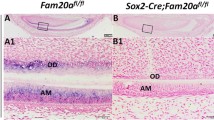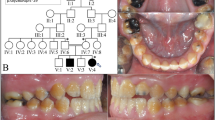Abstract
The amelogenin proteins regulate enamel mineral formation in the developing tooth. The human AMELX gene, which encodes the amelogenin proteins, is located within an intron of the Arhgap6gene. ARHGAP6 encodes a RhoGAP, which regulates activity of RhoA, a small G protein involved in intracellular signal transduction. Mice were generated in which the entire ARHGAP6 gene was deleted by Cre-mediated recombination, which also removed the nested AmelX gene. Enamel from these mice appeared chalky white, and the molars showed excessive wear. The enamel layer was hypoplastic and nonprismatic, whereas other dental tissues had normal morphology. This phenotype is similar to that reported for AmelX null mice, which have a short deletion that removed the region surrounding the translation initiation site, and resembles some forms of X-linked amelogenesis imperfecta in humans. Analysis of the enamel from the Arhgap6/AmelX-deleted mice verifies that the AmelX gene is nested within the murine Arhgap6 gene and shows that removal of the entire AmelX gene leads to a phenotype similar to the earlier AmelX null mouse results, in which no amelogenin protein was detected. However, an unusual layer of aprismatic enamel covers the enamel surface, which may be related to the 1.1-Mb deletion, which included Arhgap6 in these mice.






Similar content being viewed by others
References
JD Termine AB Belcourt PJ Christner KM Conn MU Nylen (1980) ArticleTitleProperties of dissociatively extracted fetal tooth matrix proteins I. Principal molecular species in developing bovine enamel. J Biol Chem 255 9760–9768
C Robinson SJ Brookes RC Shore J Kirkham (1998) ArticleTitleThe developing enamel matrix: nature and function Eur J Oral Sci 106 Suppl 1 282–291
M Lagerstrom N Dahl Y Nakahori Y Nakagome B Backman U Landegren et al. (1991) ArticleTitleA deletion in the amelogenin gene (AMG) causes X-linked amelogenesis imperfecta (AIH1) Genomics 10 971–975 Occurrence Handle10.1016/0888-7543(91)90187-J Occurrence Handle1916828
PS Hart TC Hart JP Simmer JT Wright (2002) ArticleTitleA nomenclature for X-linked amelogenesis imperfecta Arch Oral Biol 47 255–260 Occurrence Handle10.1016/S0003-9969(02)00005-5 Occurrence Handle11922868
T Diekwisch S David P Bringas SuffixJr V Santos HC Slavkin (1993) ArticleTitleAntisense inhibition of AMEL translation demonstrates supramolecular controls for enamel HAP crystal growth during embryonic mouse molar development Development 117 471–482 Occurrence Handle8392462
SP Lyngstadaas S Risnes BS Sproat PS Thrane HP Prydz (1995) ArticleTitleA synthetic, chemically modified ribozyme eliminates amelogenin, the major translation product in developing mouse enamel in vivo EMBO J 14 5224–5229 Occurrence Handle7489712
CW Gibson ZA Yuan B Hall G Longenecker E Chen T Thyagarajan T Sreenath JT Wright S Decker R Piddington G Harrison AB Kulkarni (2001) ArticleTitleAmelogenin-deficient mice display an amelogenesis imperfecta phenotype J Biol Chem 276 31871–31875 Occurrence Handle10.1074/jbc.M104624200 Occurrence Handle11406633
Nakahori Y, Takenaka O, Nakagome Y (1991) A human X-Y homologous region encodes “amelogenin”. Genomics 9:264–269
EC Salido PH Yen K Koprivnikar LC Yu LJ Shapiro (1992) ArticleTitleThe human enamel protein gene amelogenin is expressed from both the X and Y chromosomes Am J Hum Genet 50 303–316 Occurrence Handle1734713
EC Lau TK Mohandas LJ Shapiro HC Slavkin ML Snead (1989) ArticleTitleHuman and mouse amelogenin gene loci are on the sex chromosomes Genomics 4 162–168 Occurrence Handle10.1016/0888-7543(89)90295-4 Occurrence Handle2737677
CW Gibson EE Golub WR Abrams G Shen W Ding J Rosenbloom (1992) ArticleTitleBovine amelogenin message heterogeneity: alternative splicing and Y-chromosomal gene transcription Biochemistry 31 8384–8388 Occurrence Handle10.1021/bi00150a036 Occurrence Handle1525172
DMD Bailey NA Affara MA Ferguson-Smith (1992) ArticleTitleThe X-Y homologous gene amelogenin maps to the short arms of both the X and Y chromosomes and is highly conserved in primates Genomics 14 203–205 Occurrence Handle10.1016/S0888-7543(05)80310-6 Occurrence Handle1427830
M Girandot J-Y Sire (1998) ArticleTitleEvolution of the amelogenin gene in toothed and toothless vertebrates Eur J Oral Sci 106 IssueIDsuppl 1 501–508 Occurrence Handle9541263
SK Prakash R Paylor S Jenna N Lamarche-Vane DL Armstrong B Xu MA Mancini HY Zoghbi (2000) ArticleTitleFunctional analysis of ARHGAP6, a novel GTPase activating protein for RhoA Hum Mol Genet 9 477–488 Occurrence Handle10.1093/hmg/9.4.477 Occurrence Handle10699171
L Schaefer S Prakash HY Zoghbi (1997) ArticleTitleCloning and characterization of a novel rho-type GTPase-activating protein gene (ARHGAP6) from the critical region for microphthalmia with linear skin defects Genomics 46 268–277 Occurrence Handle10.1006/geno.1997.5040 Occurrence Handle9417914
S Etienne-Manneville A Hall (2002) ArticleTitleRho GTPases in cell biology Nature 420 629–635 Occurrence Handle10.1038/nature01148 Occurrence Handle12478284
AJ Ridley (1997) ArticleTitleThe GTP-binding protein Rho Int J Biochem Cell Biol 29 1225–1229 Occurrence Handle10.1016/S1357-2725(97)00052-6 Occurrence Handle9451818
L Aelst ParticleVan C D’Souza-Schorey (1997) ArticleTitleRho GTPases and signaling networks Genes Devel 11 2295–2322 Occurrence Handle9308960
IB Veyver ParticleVan den TA Cormier V Jurecic A Baldini HY Zoghbi (1998) ArticleTitleCharacterization and physical mapping in human and mouse of a novel RING finger gene in Xp22 Genomics 51 251–261 Occurrence Handle10.1006/geno.1998.5350 Occurrence Handle9722948
SK Prakash TA Cormier AE McCall JJ Garcia R Sierra B Haupt HY Zoghbi IB Veyver ParticleVan den (2002) ArticleTitleLoss of holocytochrome c-type synthetase causes the male lethality of X-linked dominant microphthalmia with linear skin defects (MLS) syndrome Hum Molec Genet 11 3237–3248 Occurrence Handle10.1093/hmg/11.25.3237 Occurrence Handle12444108
B Zheng AA Mills A Bradley (1999) ArticleTitleA system for rapid generation of coat color-tagged knockouts and defined chromosomal rearrangements in mice Nucleic Acids Res 27 2354–2360 Occurrence Handle10.1093/nar/27.11.2354 Occurrence Handle10325425
M Lakso JG Pichel JR German B Sauer Y Okamoto E Lee FW Alt H Westphal (1996) ArticleTitleEfficient in vivo manipulation of mouse genomic sequences at the zygote stage Proc Natl Acad Sci USA 93 5860–5865 Occurrence Handle10.1073/pnas.93.12.5860 Occurrence Handle8650183
S Hirotsune MW Fleck MJ Gambello GJ Bix A Chen GD Clark DH Ledbetter CJ McBain A Wynshaw-Boris (1998) ArticleTitleGraded reduction of Pafah1b1 (Lis1) activity results in neuronal migration defects and early embryonic lethality Nat Genet 19 333–339 Occurrence Handle10.1038/1221 Occurrence Handle9697693
Gibson, CW, Thomson, NH, Abrams, WR, Kirkham, J (2005) Nested genes: biological implications and use of AFM for analysis. Gene 350: 15–23
W Li C Mathews C Gao PK DenBesten (1998) ArticleTitleIdentification of two additional exons at the 3′ end of the amelogenin gene Arch Oral Biol 43 497–504 Occurrence Handle10.1016/S0003-9969(98)00013-2 Occurrence Handle9717587
O Baba N Takahashi T Terashima W Li PK DenBesten Y Takano (2002) ArticleTitleExpression of alternatively spliced RNA transcripts of amelogenin gene exons 8 and 9 and its end products in the rat incisor J Histochem Cytochem 50 1229–1236 Occurrence Handle12185201
A Hall (1998) ArticleTitleRho GTPases and the actin cytoskeleton Science 279 509–514 Occurrence Handle10.1126/science.279.5350.509 Occurrence Handle9438836
CE Smith MD McKee A Nanci (1987) ArticleTitleCyclic induction and rapid movement of sequential waves of new smooth-ended ameloblast modulation bands in rat incisors as visualized by polychrome fluorescent labeling and GBHA-staining of maturing enamel Adv Dent Res 1 162–175 Occurrence Handle2461208
S Nishikawa K Josephsen (1987) ArticleTitleCyclic localization of actin and its relationship to junctional complexes in maturation ameloblasts of the rat incisor Anat Rec 219 21–31 Occurrence Handle10.1002/ar.1092190106 Occurrence Handle3688458
Acknowledgement
We thank H. Zoghbi for constructive discussions. Support was provided by NIDCR grant DE11089 (CWG), NIH grant K08-HD01171 (IBV), and the neuropathology core from the Baylor College of Medicine Mental Retardation and Developmental Disabilities Research Center (NIH HD24064) (IBV). We thank Y. Liu and C. Walker for technical assistance. The 129/SvEv library containing clone 5D1 was a gift from A. Bradley.
Author information
Authors and Affiliations
Corresponding author
Rights and permissions
About this article
Cite this article
Prakash, S., Gibson, C., Wright, J. et al. Tooth Enamel Defects in Mice with a Deletion at the Arhgap6/AmelX Locus. Calcif Tissue Int 77, 23–29 (2005). https://doi.org/10.1007/s00223-004-1213-7
Received:
Accepted:
Published:
Issue Date:
DOI: https://doi.org/10.1007/s00223-004-1213-7




